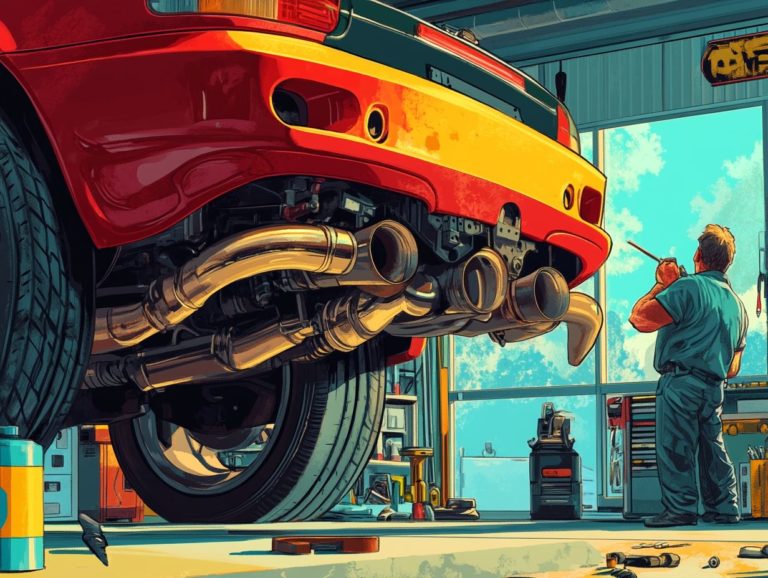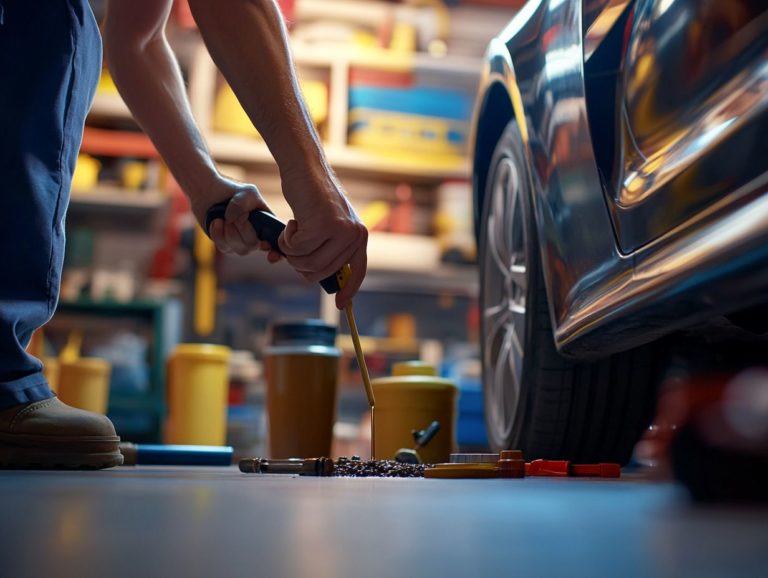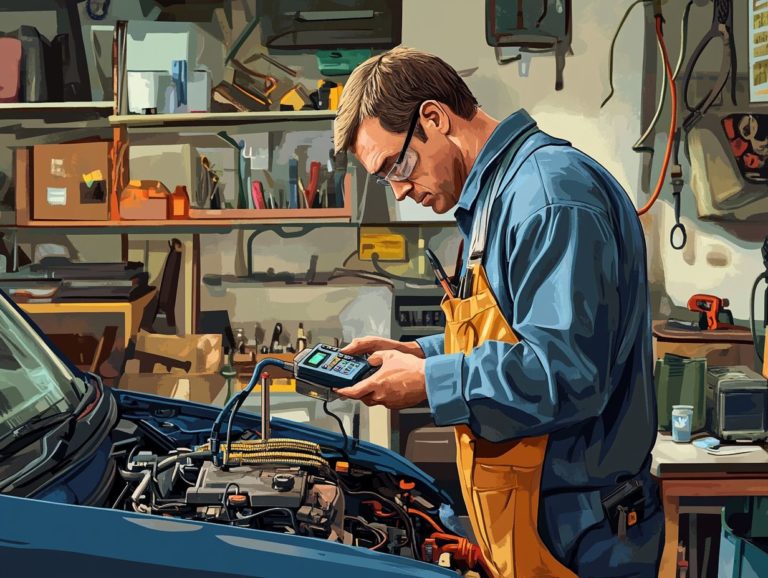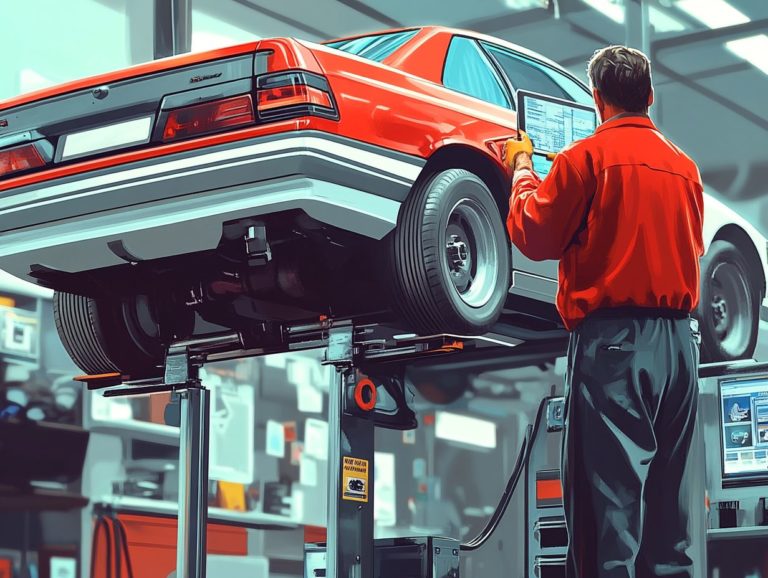What to Do When Your Car Won’t Start?
Having car troubles? Don’t worry, you’re not alone! Experiencing car troubles can be immensely frustrating. A vehicle that won t start can throw a serious wrench in your plans.
Common culprits for a car s reluctance to start include:
- A dead battery
- Problems with starting the car
- Fuel system glitches
Fortunately, you can follow troubleshooting steps to help pinpoint the issue. You ll also find guidance on when it s best to call in professionals. Plus, there are tips you can implement to prevent future starting woes.
Keep reading to regain your confidence and hit the road once more!
Contents
Key Takeaways:

- Start by checking your battery it’s often the problem! A dead battery is the most common reason for a car not starting. Make sure it has enough charge before proceeding with further troubleshooting.
- Inspect the ignition system. Faulty spark plugs or a malfunctioning starter could be the cause. If other electrical components are working, the issue could be with the ignition system.
- Know when to seek professional help. If the issue is more serious or beyond your expertise, it’s best to call for professional assistance. Signs of major problems include strange noises or smoke coming from the car.
Common Reasons for Car Not Starting
When your car refuses to start, it can be both frustrating and concerning, especially if you’re pressed for time or stranded far from home. Understanding the common reasons behind this dilemma is crucial for effective troubleshooting and preventing expensive repairs.
Consider factors like a dead battery, a malfunctioning starter motor, or issues within the electrical system. Problems with the ignition switch or a faulty fuel pump could also be at play. Don’t overlook corroded battery terminals, as they can impede the electrical flow needed for ignition.
Recognizing these potential culprits can make all the difference in getting you back on the road.
Dead Battery
A dead battery is a common problem. It often stems from simple oversights like leaving the lights on or an alternator that s not working properly.
Recognizing the signs of a dead battery is essential. You might notice dimming headlights or a sluggish engine crank when you turn the key. If you find yourself in this situation, don t fret there are effective ways to jump-start your vehicle. Just connect jumper cables from a working battery to the dead one, ensuring the connections are correct to prevent any electrical mishaps.
Keeping your battery terminals clean is crucial. Corrosion can hinder the flow of electricity, making it even trickier to start your car. A routine check and clean of these terminals can significantly extend your battery s life.
If you continue to encounter issues, it may be time to dive into troubleshooting. Testing the alternator and battery voltage will help you pinpoint any malfunctioning components within the electrical system.
Problems with Starting the Car
Problems with starting the car could very well be the reason your car isn t starting, often linked to a faulty ignition switch or troubles with the starter motor.
When you find yourself staring at an engine that simply won t come to life, you might be faced with a range of symptoms that point to underlying ignition problems. Common signs include a clicking sound when you turn the key, dim dashboard lights, or an engine that cranks but refuses to start.
To get to the bottom of these issues, it s wise to consult a skilled technician who can methodically examine the starter motor and wiring connections. Cycling the key in the ignition several times can sometimes uncover intermittent problems that might otherwise go unnoticed, emphasizing the delicate interplay between the ignition system and the engine s overall functionality.
Fuel System Problems
Fuel system problems, such as a malfunctioning fuel pump or an empty tank, can seriously hinder your car’s ability to start and run smoothly. If these issues are left unchecked, they could escalate into more severe engine complications. This highlights the importance of timely diagnostics.
To effectively identify fuel system troubles, begin by:
- Listening for any unusual sounds from the fuel pump.
- Checking for signs of fuel leakage.
- Ensuring the fuel gauge accurately reflects the levels.
Keep your fuel tank sufficiently filled to guarantee a steady gasoline supply. This also prevents sediment build-up that can clog filters and damage components. If problems arise, take charge by conducting some simple tests, including:
- Inspecting fuel lines.
- Testing the pressure with a gauge.
- Ensuring the fuel filter is clean.
These steps are essential for maintaining optimal vehicle performance.
Troubleshooting Steps
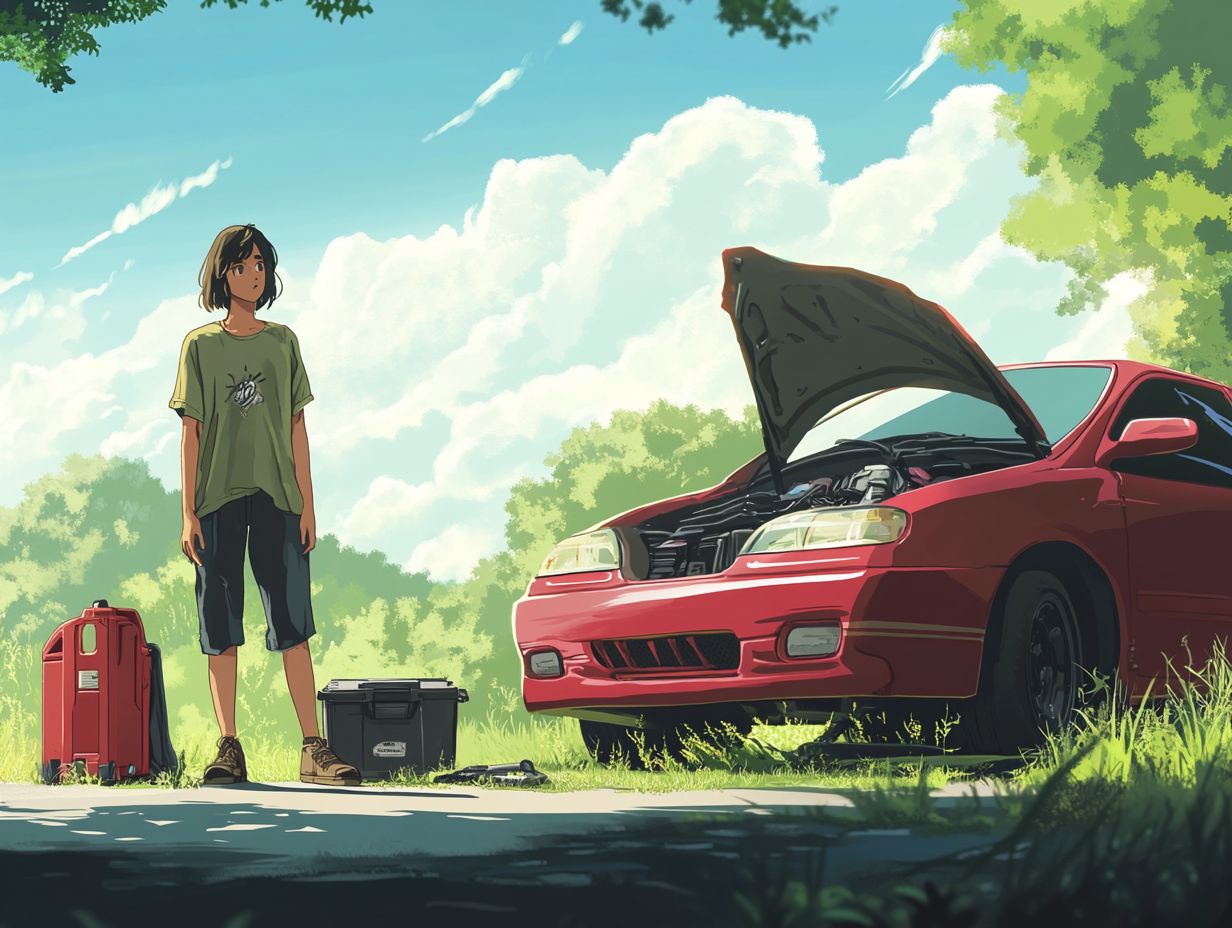
When troubleshooting car starting issues, it s essential to follow a systematic approach to identify the underlying problems efficiently. This way, you can address any malfunctions swiftly and without the unnecessary stress that often accompanies vehicle troubles.
Start by checking connections, such as battery terminals and the ignition switch, to eliminate simple issues. If you find yourself in deeper waters, don t hesitate to consult a qualified mechanic for more complex diagnostics.
By familiarizing yourself with these steps, you ll not only save time but also potentially avoid costly repairs, gaining valuable insights into your vehicle’s electrical system in the process.
Step 1: Check the Battery
The first step in troubleshooting a car that won t start is to check the battery and ensure all connections are secure and free from corrosion.
Inspecting the battery itself is essential. Worn-out terminals or frayed cables can impede the electrical flow necessary to crank the engine. Look for signs of a dead battery, such as dim headlights or unresponsive dashboard lights when you turn the key in the ignition.
Maintain clean battery terminals to enhance overall performance. Grab a wire brush to remove any buildup. Regularly checking the battery s voltage with a multimeter can significantly reduce the chances of unexpected failures, ensuring your vehicle’s electrical system stays in prime condition.
Step 2: Inspect the Ignition System
After checking the battery, your next move is to inspect the ignition system, focusing on the ignition switch and starter motor functionality.
Evaluating the ignition switch is essential, as it plays a key role in transmitting electrical signals from the battery to the starter motor, allowing the engine to crank. Cycle the key through the off and on positions several times, listening for any unusual sounds and confirming that the dashboard lights respond appropriately. If the ignition switch doesn t engage, you may find yourself unable to start the engine.
Once you’ve assessed the switch, diagnosing starter motor issues should be your next focus. Check the connections, test for voltage at the starter, and inspect the starter component; these steps will help you determine if the starter is the issue. By systematically addressing these components, you ll gain a clearer understanding of the overall health of the ignition system.
Step 3: Check the Fuel System
The final step in your troubleshooting journey involves scrutinizing the fuel system. Ensure the fuel pump is operational and that you have adequate fuel in the tank.
It s easy to overlook this, but consistent diagnostics are essential for the longevity and peak performance of your vehicle. A failing fuel pump can present various symptoms, such as a whining noise, difficulty starting, or a noticeable power drop during acceleration.
Maintaining optimal fuel levels helps you avoid these pesky issues and protects against sediment build-up in the tank, which can clog the fuel filter. Regularly inspect the fuel system for leaks or abnormalities. This could save you from costly repairs down the line and significantly enhance your automobile’s overall efficiency.
When to Call for Professional Help
Recognizing when to enlist professional help can save you not only time but also a considerable amount of frustration, especially when dealing with stubborn car issues that defy your troubleshooting efforts.
If you’ve meticulously conducted the foundational checks such as assessing the battery, ignition system, and fuel system and your vehicle remains unresponsive, don’t wait until it’s too late to call a qualified mechanic or a roadside assistance service.
These experts possess the knowledge and tools for comprehensive diagnostics and repairs that the average car owner might find overwhelming, ensuring your vehicle gets back on the road swiftly and effectively.
Signs of More Serious Issues

Recognizing the signs of more serious issues can save you from costly repairs and prevent further damage to your vehicle. It s essential for you as a car owner to stay informed.
Common symptoms, like persistent starting issues, shouldn t be brushed off; they could indicate a dead battery or a faulty starter. Pay attention to dashboard warning lights these are critical signals that something might be wrong. For example, the check engine light could mean anything from a simple gas cap problem to a more complex engine issue.
Ignoring these indicators can lead to breakdowns or severe mechanical failures. Consult a trusted mechanic at the first sign of trouble for a thorough diagnosis and appropriate remedies.
Tips for Preventing Car Starting Problems
Preventing car starting problems requires a proactive approach to maintenance and care. This ultimately saves you time, money, and stress.
Regular check-ups with a qualified mechanic, maintaining clean battery terminals, and ensuring your fuel system operates smoothly are crucial practices to adopt.
Stay alert to warning signs, like unusual sounds during startup or dashboard alerts. This awareness empowers you to tackle minor issues before they evolve into significant headaches.
Maintenance and Care
Regular maintenance and care significantly influence your chances of facing starting problems. Performing routine battery checks is essential; a weak battery can lead to frustrating situations, especially in colder temperatures.
Additionally, inspect your electrical system regularly. This means checking fuses, relays, and wiring connections for any signs of wear or corrosion that could hinder performance.
Taking a proactive approach to monitoring fluid levels, tire pressure, and brakes, along with scheduling periodic professional inspections, will extend your vehicle’s lifespan and enhance safety on the road. Engaging in these practices deepens your understanding of how your vehicle operates and elevates your driving experience.
Emergency Preparedness
Being prepared for emergencies can transform the way you manage unexpected car troubles, like discovering that your vehicle refuses to start.
Have a well-stocked emergency tool kit in your trunk. It equips you with the items necessary to address minor issues swiftly. Tools like jumper cables, a tire repair kit, and basic hand tools can prove invaluable during a breakdown.
Knowing how to jump-start your car not only gives you the power to confidently handle a dead battery situation but also offers peace of mind when those adventurous road trips call your name. Create your emergency kit today!
Know when to call for roadside assistance, as they bring the expertise and resources needed to navigate more complex problems safely and efficiently.
Frequently Asked Questions
What to Do When Your Car Won’t Start?

If your car won’t start, the first thing you should do is check the battery. Make sure it has enough charge and is connected properly. If the battery is not the issue, there could be a problem with the starter or ignition switch.
Why won’t my car start?
Your car may not start for several reasons. Common issues include a dead battery, faulty starter, ignition switch problems, or a clogged fuel filter. Consult a professional to find out what’s wrong.
Can a bad battery cause my car to not start?
Absolutely! A dead or weak battery is a common culprit. It provides the power to start your engine, and without it, the engine cannot turn over.
What should I do if my car won’t start in cold weather?
Cold weather can really strain your battery. If your car fails to start, try jump-starting it or using a battery charger. Parking in a garage or using a block heater can also help keep your car warm.
How can I prevent my car from not starting?
Regular maintenance is key! Replace your battery when needed and check the ignition system. Keep an eye on warning lights and fix any issues right away.
Should I try to start my car multiple times if it won’t start?
No, it’s best to stop trying to start the car if it won’t turn on. This can drain your battery and cause further damage. Seek professional help or troubleshoot before trying again.


